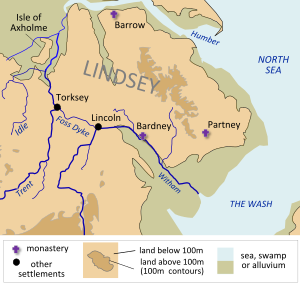Lindisfaras: Difference between revisions
wikilinking D. P. Kirby |
General534 (talk | contribs) m ce |
||
| Line 1: | Line 1: | ||
{{Short description|Anglian tribe}} |
{{Short description|Anglian tribe}} |
||
[[File:Lindsey.svg|thumb|300px|Map of Lindsey]] |
[[File:Lindsey.svg|thumb|300px|Map of Lindsey]] |
||
The '''Lindisfaras''' |
The '''Lindisfaras''' or '''Lindesfaras''' (Old English: ''Lindisfaran'') were an [[Angles (tribe)|Anglian]] tribe who, in the 6th century, established the [[kingdom of Lindsey]] between the valleys of the rivers [[Humber]] and [[River Witham|Witham]], in the north of what is now [[Lincolnshire]]. They retained their administrative independence throughout the 7th century but, following the [[Battle of the Trent]] between the kingdoms of [[Mercia]] and [[Kingdom of Northumbria|Northumbria]], remained under Mercian control until the Viking invasion of the ninth century.<ref name=Bede_IV_21>Bede, ''Ecclesiastical History'', IV, 21, p. 240.</ref><ref name="Lapidge">[[Simon Keynes]], "Wulfhere", in: ''The Blackwell Encyclopaedia of Anglo-Saxon England'', [[Michael Lapidge]] ''et al.'' (eds.), 2001.</ref> According to [[David Peter Kirby|D. P. Kirby]], the ''Heathfeld Land'' of Yorkshire mentioned as part of the Lindisfaras' 7000 hides listed in the [[Tribal Hidage]], was [[Battle of Hatfield Chase|Hatfield Chase]].<ref name="Kirby">D. P. Kirby, ''The Earliest English Kings''; 2nd ed. London: Routledge, 2001</ref> |
||
[[Lindisfarne]] in Northumbria derived its name, according to one place-name authority, from the Lindisfaras, so having the meaning "island [of the] travellers from [[Kingdom of Lindsey|Lindsey]]",<ref>A. D. Mills, ''Oxford Dictionary of English Place-Names''; 2nd ed. Oxford: OUP, 1997, p. 221</ref> indicating that the island was settled from Lindsey, or possibly that its inhabitants travelled there.<ref>[[Eilert Ekwall|Ekwall, E.]], ''The Concise Oxford Dictionary of English Place-Names''; 4th ed. Oxford: Clarendon Press, 1960, pp. 298-99 (earliest OE form quoted is "Lindisfarena ea" (island of the Lindsey people), in OE Bede, ca. 890)</ref> |
[[Lindisfarne]] in Northumbria derived its name, according to one place-name authority, from the Lindisfaras, so having the meaning "island [of the] travellers from [[Kingdom of Lindsey|Lindsey]]",<ref>A. D. Mills, ''Oxford Dictionary of English Place-Names''; 2nd ed. Oxford: OUP, 1997, p. 221</ref> indicating that the island was settled from Lindsey, or possibly that its inhabitants travelled there.<ref>[[Eilert Ekwall|Ekwall, E.]], ''The Concise Oxford Dictionary of English Place-Names''; 4th ed. Oxford: Clarendon Press, 1960, pp. 298-99 (earliest OE form quoted is "Lindisfarena ea" (island of the Lindsey people), in OE Bede, ca. 890)</ref> |
||
Latest revision as of 04:31, 11 February 2024

The Lindisfaras or Lindesfaras (Old English: Lindisfaran) were an Anglian tribe who, in the 6th century, established the kingdom of Lindsey between the valleys of the rivers Humber and Witham, in the north of what is now Lincolnshire. They retained their administrative independence throughout the 7th century but, following the Battle of the Trent between the kingdoms of Mercia and Northumbria, remained under Mercian control until the Viking invasion of the ninth century.[1][2] According to D. P. Kirby, the Heathfeld Land of Yorkshire mentioned as part of the Lindisfaras' 7000 hides listed in the Tribal Hidage, was Hatfield Chase.[3]
Lindisfarne in Northumbria derived its name, according to one place-name authority, from the Lindisfaras, so having the meaning "island [of the] travellers from Lindsey",[4] indicating that the island was settled from Lindsey, or possibly that its inhabitants travelled there.[5]
See also
[edit]References
[edit]- ^ Bede, Ecclesiastical History, IV, 21, p. 240.
- ^ Simon Keynes, "Wulfhere", in: The Blackwell Encyclopaedia of Anglo-Saxon England, Michael Lapidge et al. (eds.), 2001.
- ^ D. P. Kirby, The Earliest English Kings; 2nd ed. London: Routledge, 2001
- ^ A. D. Mills, Oxford Dictionary of English Place-Names; 2nd ed. Oxford: OUP, 1997, p. 221
- ^ Ekwall, E., The Concise Oxford Dictionary of English Place-Names; 4th ed. Oxford: Clarendon Press, 1960, pp. 298-99 (earliest OE form quoted is "Lindisfarena ea" (island of the Lindsey people), in OE Bede, ca. 890)
